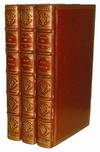

Mind the Curve : A History of cable Trams
by Keating, John D
- Used
- Good
- Paperback
- Condition
- Good/No Jacket
- Seller
-
Melbourne, Victoria, Australia
Payment Methods Accepted
About This Item
Melbourne, Victoria, Australia: Transit Australia Publishing, 1996. Reprint . Soft cover. Good/No Jacket. 155 pages b/w photos - Operating from 1885 until 1940, Melbourne's cable tram system was the fourth biggest in the world, with about 75 km of double track, 17 inner-suburban routes, and 600 cable car and trailer sets. Cable trams depended for their motive power on a cable in a slot between the rails, kept moving by an engine house along the route. In the first car (the dummy), the driver (the gripman) worked the levers that gripped the cable to make the tram move. Passengers could ride in the dummy, but apart from the roof it was quite open. To warn passengers to hold on when the tram departed from a straight line, the gripman usually called 'mind the curve!' The second car was more like a conventional small tram, but was only a trailer, pulled along by the dummy. Melbourne's first cable tram ran on 11 November 1885 from Spencer Street along Flinders Street and Bridge Road Richmond, about 5 km to Hawthorn Bridge. The last ran on 26 October 1940 from the intersection of Spencer and Bourke streets to the terminus at Northcote. Although built over eight years by a Tramway Trust formed by 12 inner-city municipalities, Melbourne's main cable tram routes were until 1916 run by the Melbourne Tramway and Omnibus Co., a private enterprise operation managed by Francis Boardman Clapp and Henry Hoyt. The economic collapse of the early 1890s limited further development of the network which remained the crux of Melbourne's street transport system until the late 1920s. Independent electric tram systems were set up as feeder lines to the cable tram terminuses. After the whole system was taken over by the Victorian Government, electric trams began to appear in the city. They replaced cable trams in Swanston Street in 1926, Flinders Street in 1927, Collins Street in 1929 and, finally, Bourke Street in 1940. Traces of the cable tram system are barely visible in the city landscape. Rathdowne Street owes its median strip to the North Carlton-St Kilda line, closed in 1936, the engine house at Park Street now converted to apartments. The restored Cable Tram No. 1 is on display at Melbourne Museum.
Reviews
(Log in or Create an Account first!)
Details
- Seller
- Train World Pty Ltd
(AU)
- Seller's Inventory #
- UB-07727
- Title
- Mind the Curve : A History of cable Trams
- Author
- Keating, John D
- Format/Binding
- Soft cover
- Book Condition
- Used - Good
- Jacket Condition
- No Jacket
- Quantity Available
- 1
- Edition
- Reprint
- Binding
- Paperback
- Publisher
- Transit Australia Publishing
- Place of Publication
- Melbourne, Victoria, Australia
- Date Published
- 1996
- Weight
- 0.00 lbs
- Keywords
- USED-Australia
- Bookseller catalogs
- USED-Australia;
Terms of Sale
Train World Pty Ltd
Payment in Advance before posting, and your postage cost is the same cost charged us by Australia Post.
About the Seller
Train World Pty Ltd
Biblio member since 2008
Melbourne, Victoria
About Train World Pty Ltd
Train World commenced business at 615 Hawthorn road East Brighton in 1973. From a cabinet in a haberdashery store, Train World grew to take over half the shop in 1974 to take over the entire store and by 1977 it had taken over the shop and the rear residence. In 1981 the shop moved across the road to 624 Hawthorn Road East Brighton. Here too the shop grew and grew. So that by 1995 it had taken over the shop, the storage room area, the staff area, the garage, the rear warehouse and finally filling the entire building. Finally on 1st July 2012 Train world moved again to 290 Bay Street Brighton - Since the 1980s the focus of Train World has been trains and model trains, nothing but trains and everything to do with trains. Making it the largest pure train shop in Australia. Train World is a store of some 2,000 square feet. Open seven (7) days a week, that specialise not only in train models but new and used books and magazines of British, American and Australian titles. We usually have 7,000-8,000 titles in stock at any time. Plus we are the Australasian/Pacific Rim distributor for Irwell Press. We have a large holding of current and past new Irwell Press Books. On our home web site Irwell Press and our new / secondhand / used books are listed seperately. and can also be searched by clicking on the search link. We are displaying the covers and details for all our new Australian books and Irwell Press books on library thing. try this link http://www.librarything.com/catalog/TrainWorldand then click on TrainWorld has a suggested style for viewing this library (use it)
Glossary
Some terminology that may be used in this description includes:


